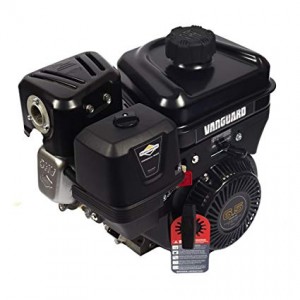 With Subaru ending production of small engines, Billy Goat is switching over to single-cylinder Briggs & Stratton Vanguard engines for their smaller equipment. The new OS552 overseeder, PL1801 PLUGR aerator or F601V walk-behind blower all use a 205cc, 6.5 HP Vanguard engine. Here’s what you need to know to keep this engine in top shape to power your equipment.
With Subaru ending production of small engines, Billy Goat is switching over to single-cylinder Briggs & Stratton Vanguard engines for their smaller equipment. The new OS552 overseeder, PL1801 PLUGR aerator or F601V walk-behind blower all use a 205cc, 6.5 HP Vanguard engine. Here’s what you need to know to keep this engine in top shape to power your equipment.
Before You Begin
Before servicing your engine, disconnect the spark plug to prevent an accidental start. If the engine needs to be tilted, drain the fuel tank to keep the carburetor from being flooded and keep gasoline from coming in contact with hot engine components.
Maintenance Schedule
First 5 hours of operation: Change the oil.
Every 8 hours or daily: Check the oil level and clean the muffler, controls, and intake.
Every 25 hours or annually: Clean the air filter and pre-cleaner (if equipped.)
Every 50 hours or annually: Change the oil and clean the exhaust.
Annually: Change the spark plug, air filter, and pre-cleaner. Clean the fuel system. If you operate in dusty conditions, clean the cooling fins.
Briggs & Stratton recommends having a dealer check the valve clearance each year.
Oil
Some versions of this engine come with a low oil protection system. If the engine won’t start or stops suddenly, make sure it has enough oil.
To check the oil level, set the equipment on a flat surface. Remove the dipstick, wipe off any oil, and insert it into the engine without screwing it in. The oil should come up to the full mark on the dipstick. When adding oil, it should reach the edge of the oil fill port.
Briggs & Stratton recommends using motor oil with an SAE rating of SF or higher. 10W30 can be used at temperatures ranging from 0-100°F, synthetic 5W30 below 100°F, and Vanguard synthetic 15W50 above 20°F. Oil capacity for the Model 130000 engine is 20-22 oz, while the Model 190000 holds 26-28 oz.
To change the oil, remove the dipstick and drain plug. Once the oil has drained from the crankcase, install the plug and add oil through the fill port. Check the oil level and top up the engine as needed.
Fuel
This engine is designed to run on unleaded gas with an octane rating of 87 or higher and up to 10% ethanol. 85 octane fuel can be used at altitudes above 5,000 feet.
When adding fuel, don’t fill the tank above the bottom of the filler neck. This space is needed for fuel expansion as the engine warms up. Briggs & Stratton recommends using a fuel stabilizer when adding fuel to the tank. If the fuel is not treated, it should be used within 30 days of purchase.
Check the fuel lines for signs of cracking and replace as needed. Some models have an in-line fuel filter that needs to be replaced periodically. Before replacing the lines or filter, drain the fuel tank and shut off the fuel valve. Some versions also have a filter screen inside the tank filler neck that should be cleaned periodically.
Spark Plug
The electrode gap should be 0.030 inches. When installing the plug, torque it to 180 in-lbs.
Exhaust System
Give the engine time to cool off before working on the exhaust: it can stay hot up to a half hour after the engine was shut off. Clean off any debris, then remove the deflector or spark arrester. If either part has heavy carbon build-up, replace it.
Air Filter
There are three air box designs used with this engine. If there is a large airbox with a thumb screw next to the fuel tank, remove the screw and pull off the cover. Underneath, you’ll find either a circular foam filter surrounding a support cup or an oblong paper filter with a foam pre-cleaner. Remove the wing nut, then slide the filter out of the air box. If there is a plastic side panel on the carburetor, unscrew the panel, then pull the paper air filter and foam pre-cleaner out of the air box.
Foam filters cleaners should be cleaned with soapy water and allowed to dry before reinstalling. These should not be oiled. Foam filters also need to be washed and dried. After drying, soak the filter in clean engine oil, then squeeze out the excess using a clean towel. Clean paper filter elements by tapping them against a hard surface to knock off loose dirt.
Need Parts for Your Billy Goat’s Engine?
Billygoatparts.com isn’t just an authorized Billy Goat dealer, we’re also a dealer for all of their manufacturing partners including Briggs & Stratton Vanguard. That means you can get everything you need for your equipment from one location. To find the parts for your engine, just select your model and serial number, and our site will show you compatible parts with factory diagrams and descriptions. We ship across the United States and Canada.
